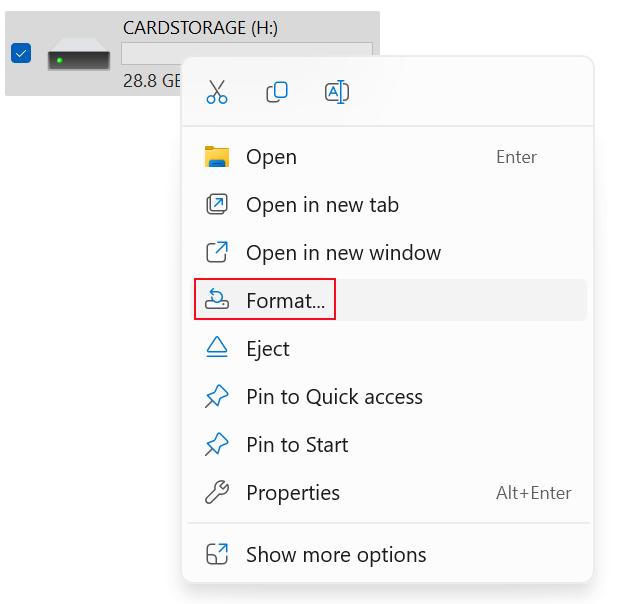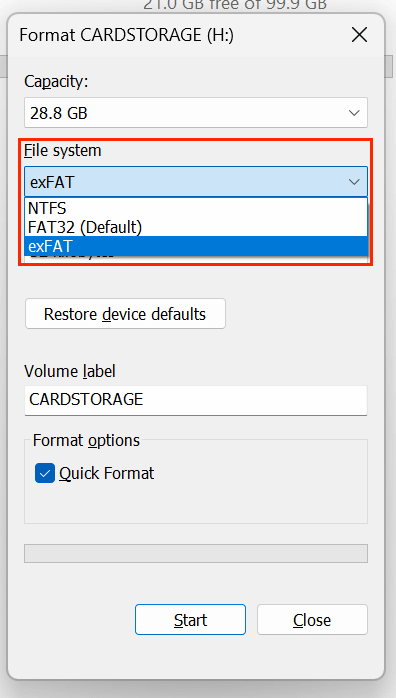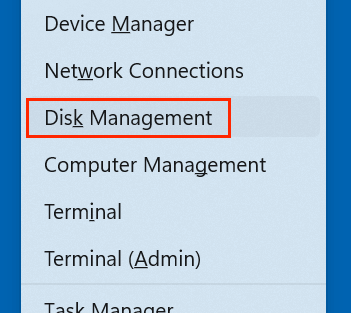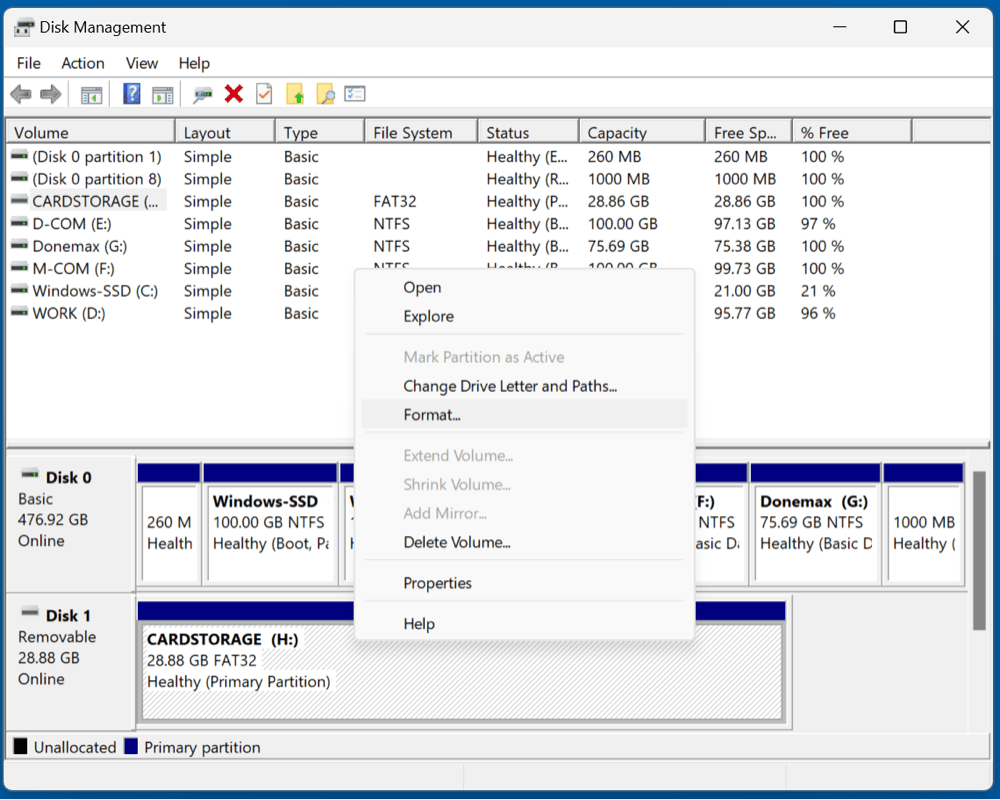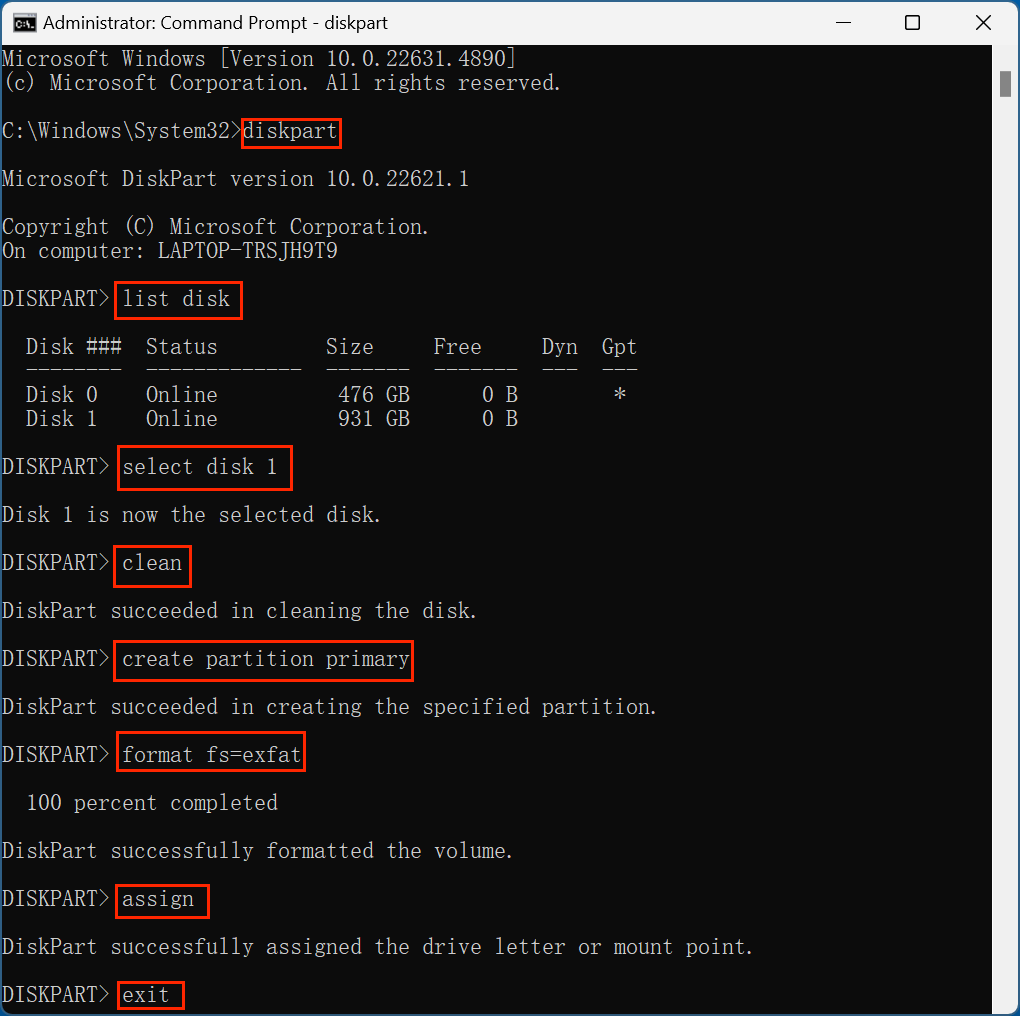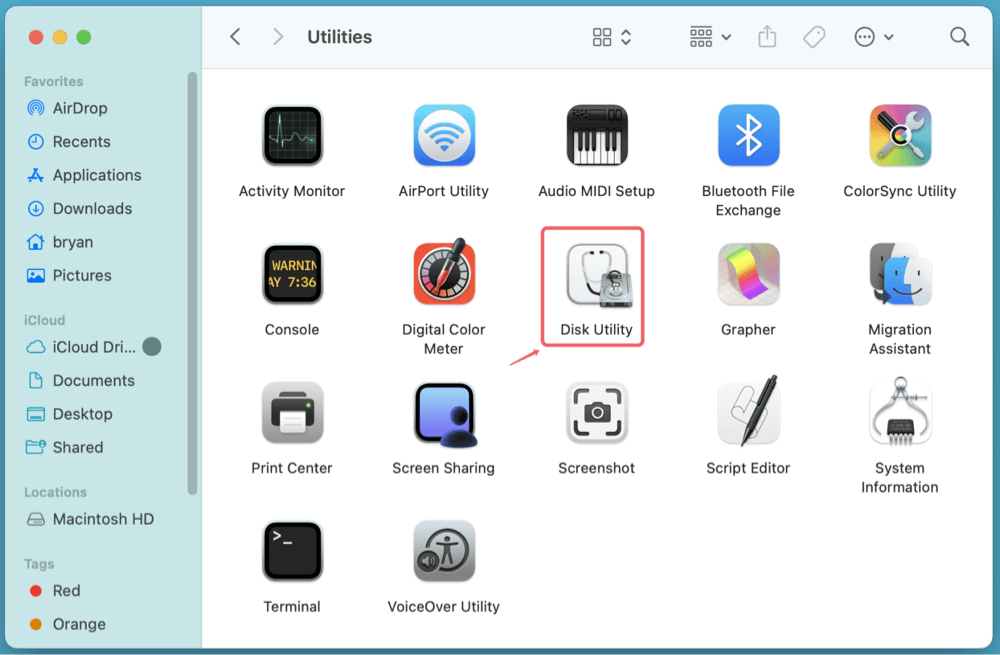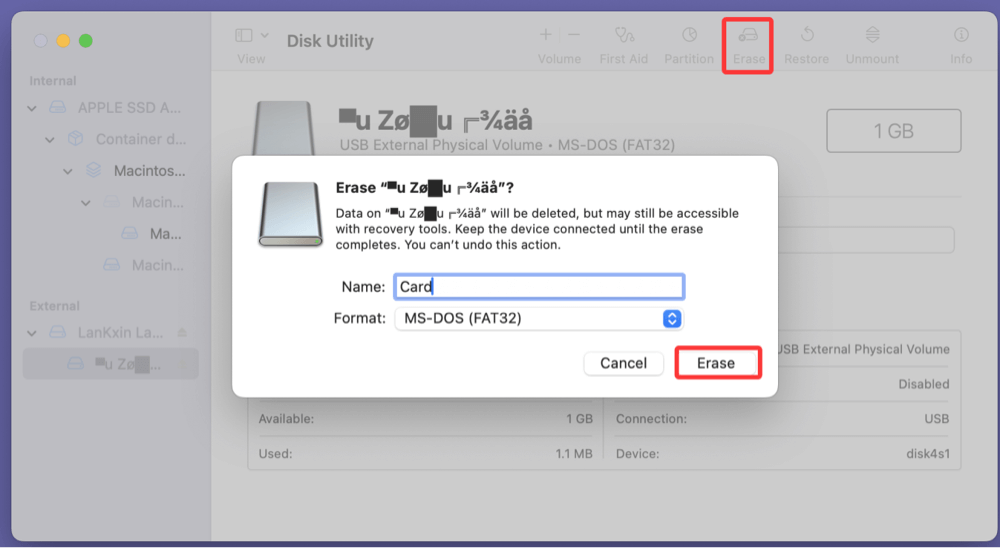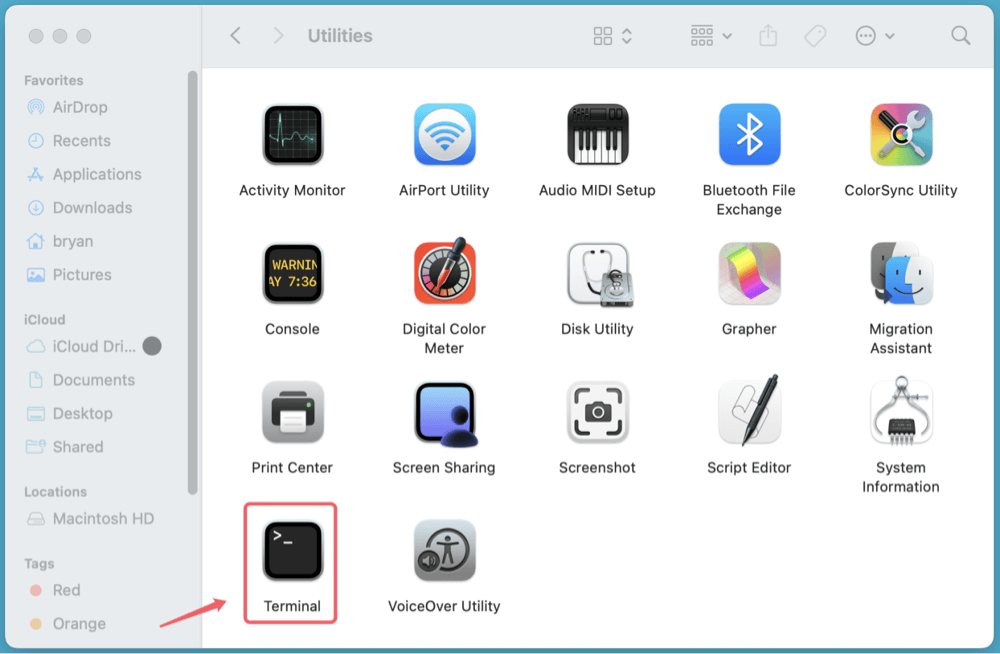Before we start: Donemax Data Eraser can help you quickly format a CF card on Windows or macOS. It even can help you wipe your CF card before you sell, donate or dispose of it. Once the CF card is wiped by Donemax Data Eraser, all data stored on it is lost for good, can't be recovered by any method.
PAGE CONTENT:
- Understanding CF Card Formatting
- How to Format a CF Card on Windows?
- How to Format a CF Card on macOS?
- CF Card Formatting Tips and Best Practices
- Troubleshooting Common CF Card Formatting Issues
- Recovering Data from Formatted or Corrupted CF Card
- How to Wipe CF Card Before Selling/Donating? [Files Unrecoverable]
- Conclusion
CompactFlash (CF) cards have been a staple in the world of professional photography, videography, and industrial data storage for years. Known for their durability and high-speed performance, CF cards are still widely used in DSLR cameras, industrial equipment, and legacy devices. However, like all forms of removable storage, CF cards occasionally require formatting - whether to resolve corruption issues, prepare them for new devices, or simply clear old data.
In this guide, we'll walk you through everything you need to know about formatting a CF card on both Windows and macOS, including step-by-step instructions, tips, and troubleshooting steps to ensure your data storage is ready to use.

Understanding CF Card Formatting
What Does Formatting a CF Card Do?
Formatting a CF card essentially prepares the card for storage use by setting up a file system. This process erases all existing data and recreates the file system structure. The benefits of formatting include:
- Resolving logical errors or corruption
- Improving compatibility with new devices
- Reclaiming space used by hidden system files
- Boosting performance and preventing lag
File System Options
When formatting, the choice of file system is crucial:
- FAT32: Compatible with most devices, especially older cameras and embedded systems. However, it has a 4GB file size limit.
- exFAT: Ideal for newer cameras and operating systems, supporting larger files and better performance than FAT32.
- NTFS: Primarily for use with Windows systems, with limited compatibility with non-Windows devices.
- APFS/macOS Extended (Journaled): Specific to Mac users but not recognized by Windows or most cameras.
For CF cards used in cameras or cross-platform environments, FAT32 or exFAT is usually recommended.
When Should You Format a CF Card?
- When setting up a brand new card
- After transferring files to free up space
- If the card is not recognized by your device
- To remove viruses or corrupted data
- Before using the card in a different operating system or camera
⭐ Important: Always back up important files before formatting, as the process deletes all stored data.
How to Format a CF Card on Windows?
Method 1: Using File Explorer to Format the CF Card
This is the simplest way to format a CF card on a Windows computer.
Steps:
- Insert the CF card into a compatible card reader connected to your PC.
- Open File Explorer and locate the CF card under "This PC".
- Right-click on the CF card and select Format.
![wipe CF card]()
- Choose:
- File System: FAT32 or exFAT
- Allocation Unit Size: Default
- Volume Label: Name your card (optional)
![wipe CF card]()
- Tick Quick Format (for faster formatting), or uncheck it for a deep format.
- Click Start and confirm.
![wipe CF card]()
Method 2: Using Disk Management to Format Your CF Card
Disk Management is useful when File Explorer can't recognize the card or throws errors.
Steps:
- Press Windows + X and select Disk Management.
![wipe CF card]()
- Locate your CF card in the volume list.
- Right-click the volume and select Format.
![wipe CF card]()
- Choose the file system (FAT32 or exFAT), and configure label and settings.
- Click OK to begin formatting.
![wipe CF card]()
If your CF card shows as "Unallocated", right-click it and choose New Simple Volume, then follow the prompts to format it.
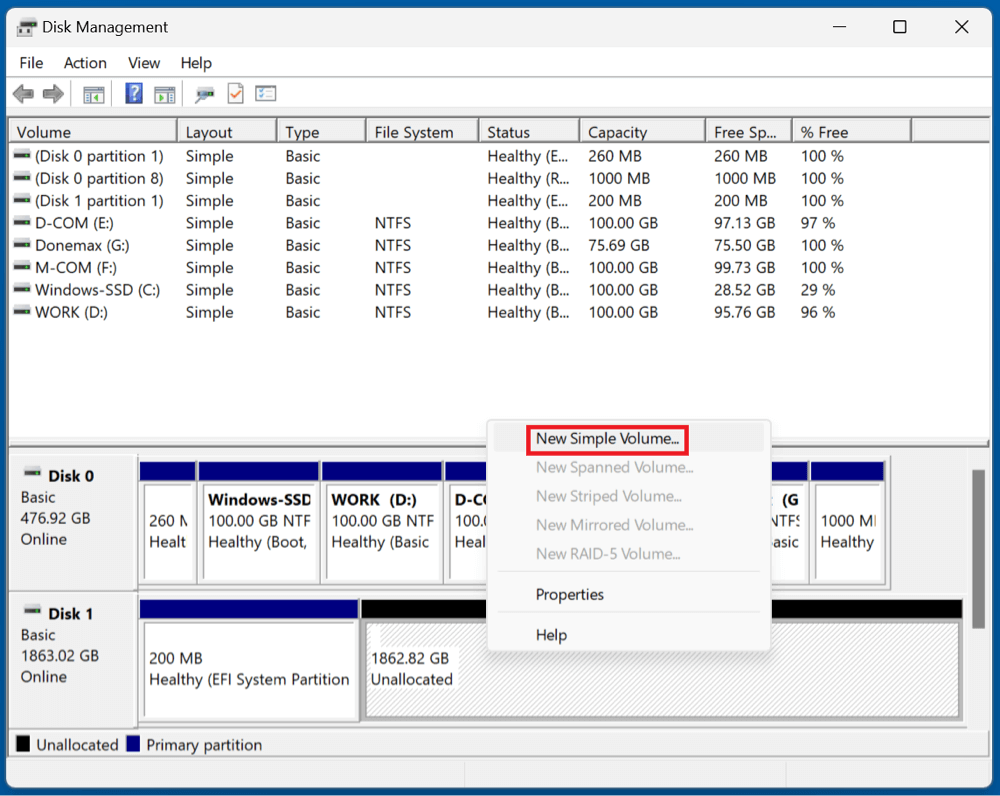
Method 3: Using Command Prompt to Format the CF Card
The Command Prompt method can be used to clean and format stubborn cards.
Steps:
- Search for CMD, right-click it, and choose Run as Administrator.
- Type:
diskpart
- In the DiskPart prompt, type:
list disk
- Identify your CF card by size, then:
select disk X (replace X with your CF card's number)
clean
create partition primary
format fs=exfat quick
assign
Exit![wipe CF card]()
This command will clean the card, remove all partitions, and format it in the desired file system.
How to Format a CF Card on macOS?
Method 1: Using Disk Utility to Format the CF Card
Disk Utility provides a user-friendly way to format storage devices.
Steps:
- Insert your CF card into the card reader connected to your Mac.
- Open Disk Utility from Utilities via Applications.
![wipe CF card]()
- In the sidebar, select your CF card (make sure to select the device, not the volume).
- Click Erase at the top of the window.
- Configure the following:
- Name: Enter a name for the CF card
- Format: Choose MS-DOS (FAT) for FAT32 or exFAT for larger files
- Click Erase and wait for the process to complete.
![wipe CF card]()
Method 2: Using Terminal to Format the CF Card
If Disk Utility fails, Terminal offers a powerful alternative.
Steps:
- Open Terminal from Utilities via Applications.
![wipe CF card]()
- Type the below command to list drives:
diskutil list
- Identify your CF card (e.g., disk2), then type:
diskutil eraseDisk exFAT CF_CARD MBRFormat /dev/disk4
- Replace disk2 with your card's identifier
- CF_CARD is your desired label
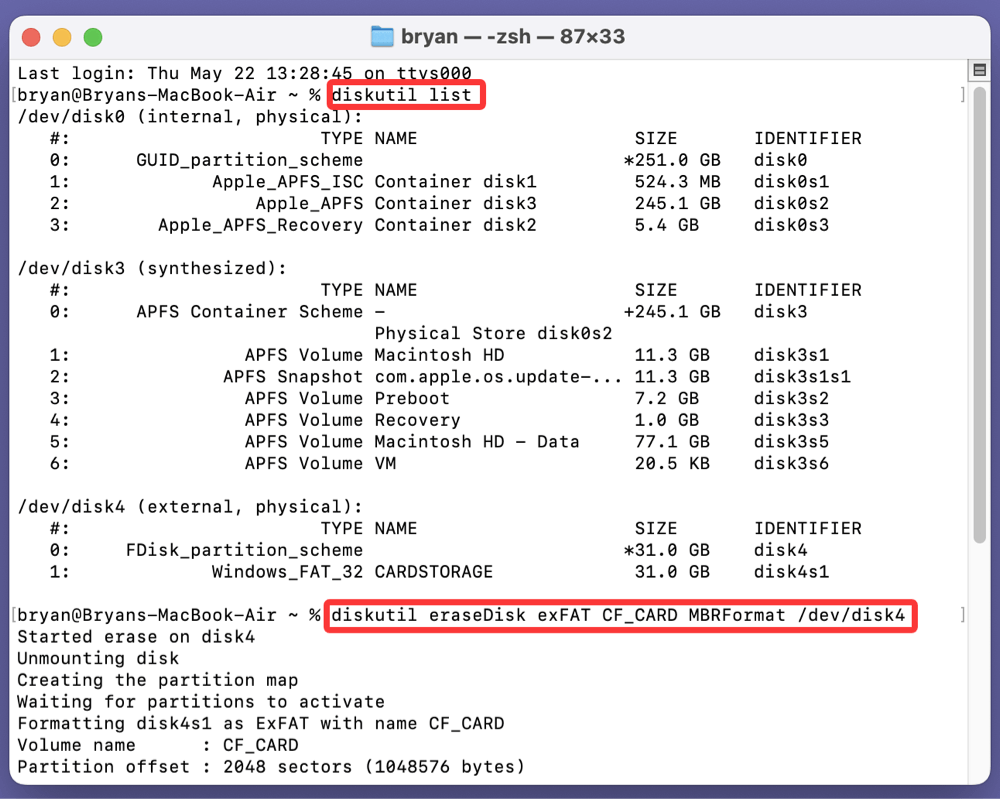
This command will erase and format the CF card using exFAT and Master Boot Record.
CF Card Formatting Tips and Best Practices
1. Always Back Up Your Data Before Formatting
Formatting deletes all data stored on the CF card. Even if you choose "Quick Format," your files are no longer accessible through standard file explorers. Therefore, it's critical to back up your data:
- Photographers should immediately copy their RAW/JPEG files to a computer or cloud storage before formatting.
- Use tools like FreeFileSync or rsync (on macOS/Linux) to automate backups.
- Consider creating a full disk image backup using software like Donemax Disk Clone or dd on Linux/macOS if the card contains important configuration or bootable files.
2. Use a High-Quality CF Card Reader
A faulty or low-quality card reader can lead to:
- Intermittent connections
- Incomplete formatting
- Corrupt file systems
- Slower read/write speeds
💡 Tip: Invest in a USB 3.0 or USB-C reader from reputable brands like Lexar, SanDisk, or Transcend. If you often format multiple types of cards, consider a multi-card reader that supports CF, SD, microSD, and others.
3. Avoid USB Hubs and Adapters
Although USB hubs are convenient, especially for laptops with limited ports, they can introduce:
- Power supply issues
- Data transmission instability
- Increased risk of disconnections during formatting
Always connect the card reader directly to the computer's USB port. If you must use a hub, ensure it is powered and from a reliable brand.
4. Format In-Camera After Transferring Files
If you're using your CF card in a DSLR or cinema camera (e.g., Canon EOS 5D Mark IV), it’s a good habit to:
- First copy your files to your computer.
- Then format the CF card within the camera's settings menu instead of your PC.
Why? Because:
- The camera applies its own directory structure and metadata files.
- This ensures full compatibility and avoids recording errors.
- It can also prevent corruption that sometimes occurs when a computer and camera manage files differently.
5. Watch Out for Physical Write Protection or Lock Switches
Some CF card adapters or readers have physical switches that enable write protection. When write protection is enabled:
- The system may detect the card but won't allow you to format it.
- You'll see error messages like "Access Denied" or "The disk is write protected."
Solution:
- Remove the card and inspect for any switch or slider.
- Ensure the switch is in the "unlocked" position before reinserting and formatting.
6. Use Full Format Occasionally, Not Always
You typically get the option of Quick Format and Full Format:
- Quick Format: Clears the file table but leaves data sectors untouched. It's fast but doesn't check for bad sectors.
- Full Format: Scans for bad sectors and writes zeroes to the entire disk.
- Detect potential failing sectors early
- Refresh the card's data structure
- Prevent file system fragmentation
However, frequent full formats may shorten the CF card's life due to write cycles. Use them wisely.
Troubleshooting Common CF Card Formatting Issues
Problem 1: CF Card Not Recognized
Cause: Faulty reader, outdated drivers, or corrupted card.
Solution:
- Try a different USB port or card reader.
- Restart your computer.
- Update USB and storage drivers.
- Check Disk Utility (macOS) or Disk Management (Windows) to see if the card appears.
Problem 2: "Windows Was Unable to Complete the Format"
Cause: Corruption, bad sectors, or unsupported file system.
Solution:
- Use Disk Management or DiskPart.
- Try formatting with a third-party tool.
- Run chkdsk on the card to check for file system errors.
Problem 3: Disk Utility Can't Erase the Card
Cause: macOS may fail to unmount the disk or doesn't support the format.
Solution:
- Use Terminal with diskutil commands.
- Ensure the CF card isn't in use or mounted elsewhere.
- Try formatting on a Windows machine.
Recovering Data from Formatted or Corrupted CF Card
Formatting will erase everything from the CF card. If you have important data stored on the CF card and the CF card has been formatted, you can use data recovery software to help recover lost data including videos and images.
Step 1. Download and install the reliable data recovery program - such as Donemax Data Recovery.
Step 2. Connect the CF card to your computer, then open Donemax Data Recovery, select the CF card.
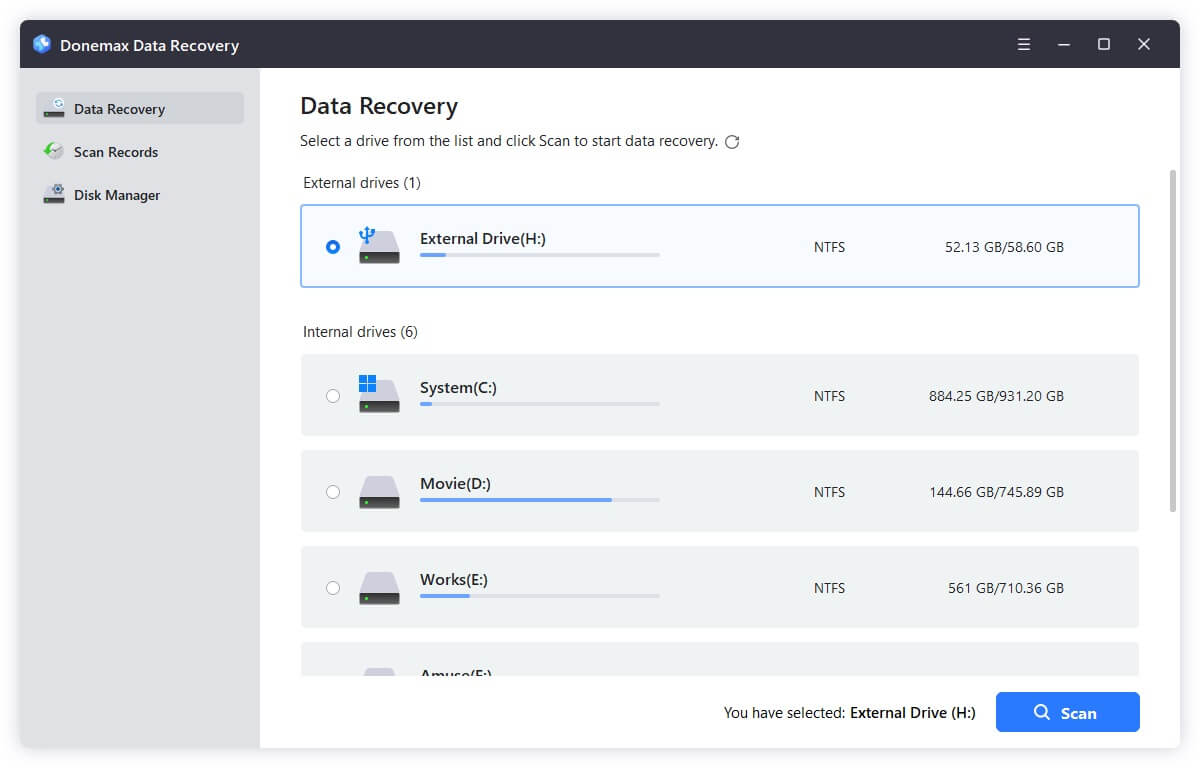
Step 3. Click on Scan button. It will deeply scan the CF card and find all deleted/erased/inaccessible files.
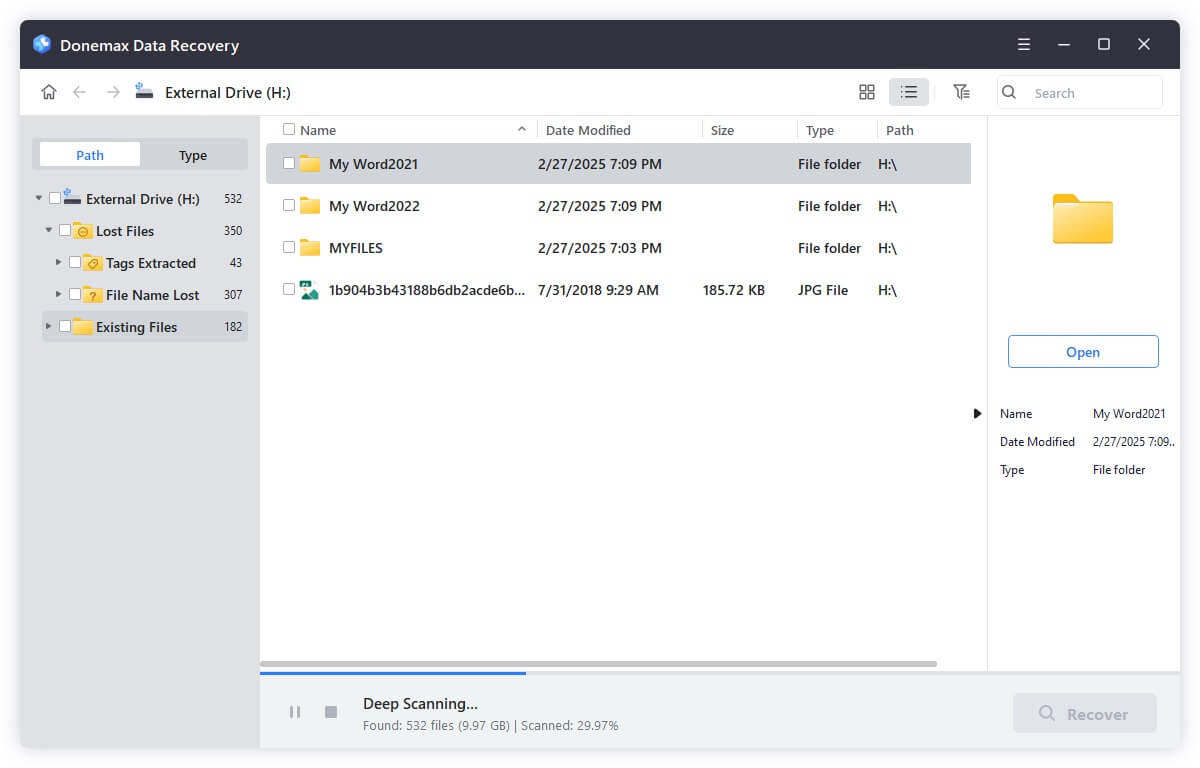
Step 4. After scanning, you can preview all recoverable files. Then select the wanted files, click on Recover button to save them.
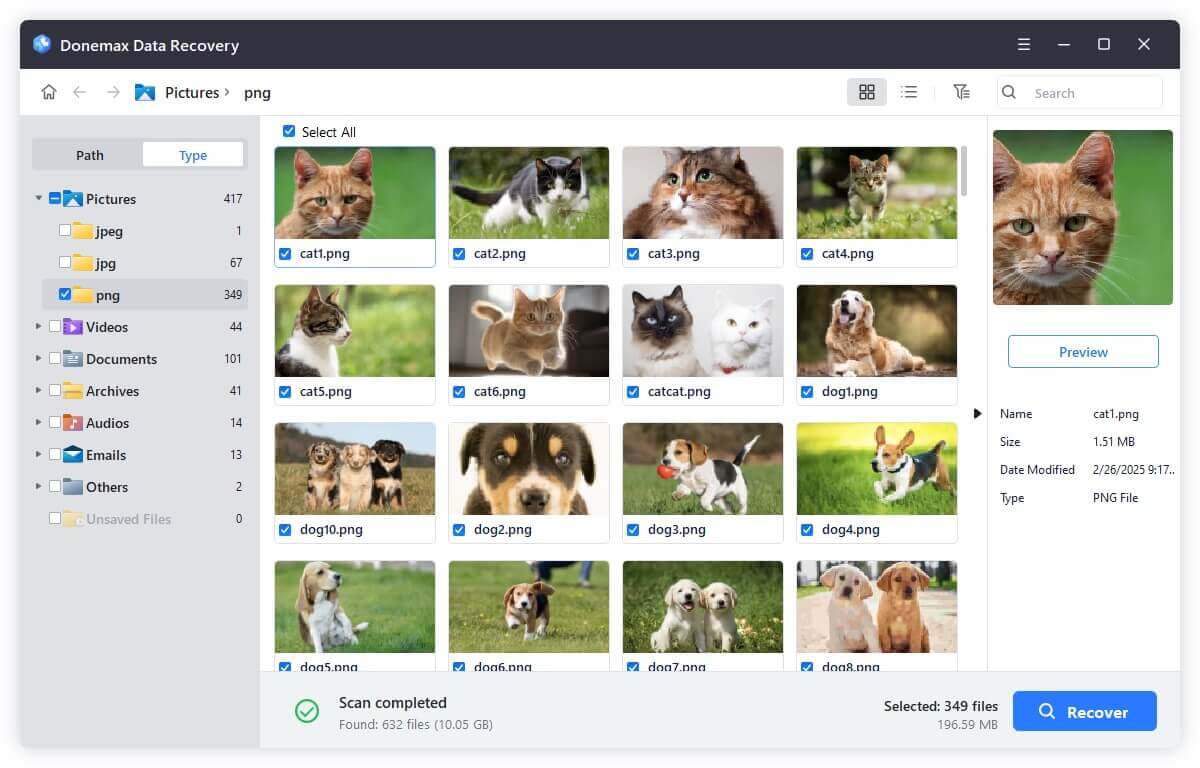
How to Wipe CF Card Before Selling/Donating? [Files Unrecoverable]
If you will sell, donate or dispose of an old CF card, you should permanently erase all data from it to prevent potential data recovery. Disk wipe software - such as Donemax Data Eraser can help format and wipe the CF card. All data stored on the CF card will be erased permanently, no trace left behind.
Step 1. Download and install Donemax Data Eraser on your computer.
Step 2. Open Donemax Data Eraser, choose Erase Hard Drive mode. Then select the CF card, click on Erase Now button.

Step 3. It will format and wipe the CF card. All data (existing data, hidden data, deleted/formatted/lost data) stored on the CF card will be erased permanently, can't be recovered by any method.
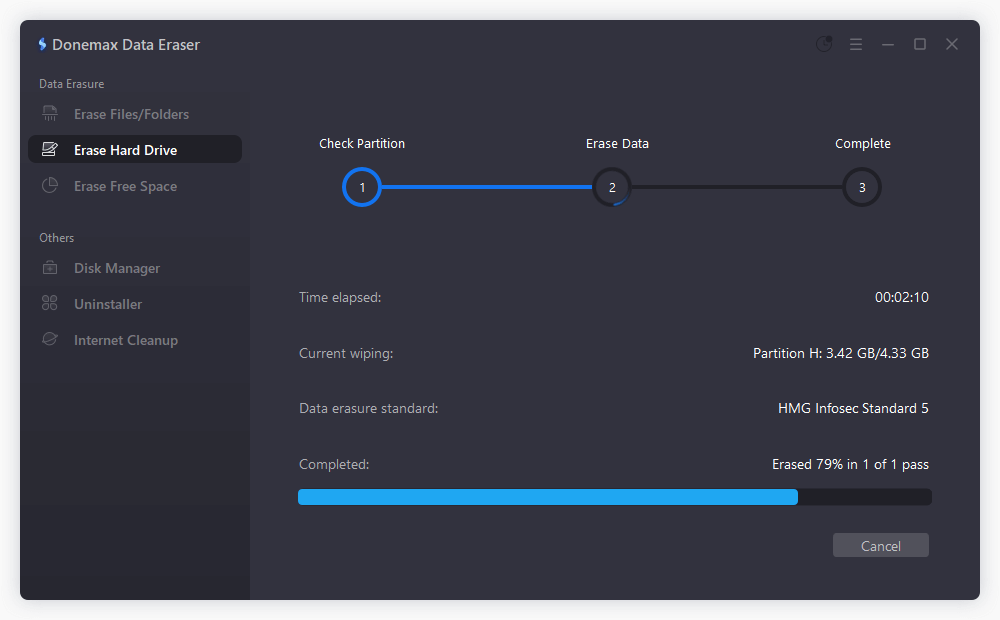
Conclusion
Formatting a CF card is a straightforward process when done correctly and with the proper tools. Whether you're using Windows or macOS, both operating systems offer built-in utilities for formatting, and advanced users can benefit from command-line methods or third-party software.
Key takeaways:
- Choose the right file system based on your device (FAT32 for compatibility, exFAT for large files).
- Always back up data before formatting.
- Use trusted readers and update drivers regularly.
- Format within the camera when needed for full compatibility.
By following the steps outlined in this guide, you can ensure that your CF card is formatted properly and ready to perform reliably - whether you're capturing high-resolution images or transferring mission-critical data.


Donemax Data Eraser
One of the best data erasure programs for permanently erase data from PC, Mac, HDD, SSD, USB drive, digital camera and other devices. Once the data is erased, it is lost for good, cannot be recovered by any method.
Related Articles
- Mar 19, 2025How to Use Seagate Game Drive PS5 SSD?
- Nov 25, 2024How to Clean Install macOS Monterey [Step-by-step Guide]
- May 19, 2025Clean Install macOS Ventura: A Comprehensive Guide
- Mar 27, 2025How to Use BitLocker on Windows 11?
- Jul 10, 2024Factory Reset Dell Laptop and Wipe All Private Data Before Selling/Donating
- Sep 22, 2025How to Reinstall macOS Tahoe – Complete Guide 2025

Steven
Steven has been a senior writer & editor of Donemax software since 2020. He's a super nerd and can't imagine the life without a computer. Over 6 years of experience of writing technical solutions and software tesing, he is passionate about providing solutions and tips for Windows and Mac users.

Gerhard Chou
In order to effectively solve the problems for our customers, every article and troubleshooting solution published on our website has been strictly tested and practiced. Our editors love researching and using computers and testing software, and are willing to help computer users with their problems

